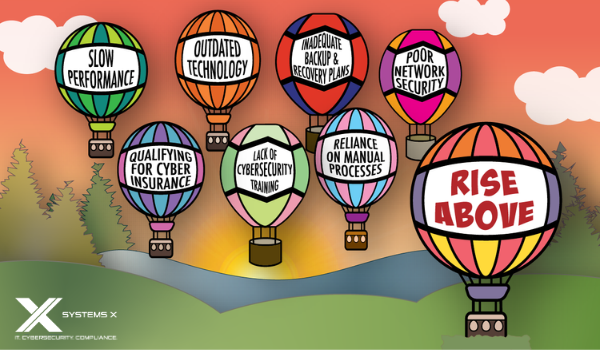15 Technology Challenges Businesses May Face in 2023
Being able to overcome challenges is one of the keys to success in business. Technology challenges are no exception. Efficiently dealing with...

Every business needs technology, from the C-Suite down to tech support. We all know how it goes: over budget now, pay more later - tech spend adds up fast. That's why the savviest of businesses are smart about their IT budget.
Having an IT budget in place helps you save money down the line. You are assured that your organization will have the resources to make strategic technology investments whenever necessary.
Whether you're looking to cut costs or secure more funds for the next big project, having an IT budget is essential. With the right approach, you can make sure your tech investments are practical and efficient while keeping your budget in check. Learn how creating a financial plan for your tech investments can help you save money and create efficiency across your entire organization.
An IT budget is a financial plan that outlines the anticipated costs associated with an organization's IT needs for a specific period, usually a fiscal year. It's often broken down into categories, including:
An IT budget acts as a roadmap that ensures you can allocate resources ahead of time and keep track of where they're going and what they're being used for. Having one in place allows you to anticipate future needs and make sure your business can pivot quickly when necessary.
An IT budget is essential for any business that wants to remain competitive in today's digital world. It helps keep spending organized and cuts down on surprise costs. You focus on what matters- improving your network's reliability, increasing data security, and saving money in the long run. Creating a well-planned and well-managed IT budget aligns your IT investments with your overall business goals and objectives.
When running efficient and secure IT operations, you must have a plan. But why should you invest in an IT budget? Here are the benefits of an IT budget:
Instead of allocating money as you go, an IT budget helps businesses to allocate resources and plan their spending on IT initiatives in a more structured way. This enhances financial planning and budgeting, as businesses can predict IT costs and expenses more accurately.
An IT budget enables informed decision-making by providing accurate and up-to-date financial information about IT spending. This allows stakeholders to evaluate the cost-effectiveness of various IT initiatives. By evaluating the potential return on investment for various IT initiatives, businesses can decide which projects to fund and which to postpone or forgo.
An IT budget helps increase efficiency by focusing resources on projects most likely to deliver the greatest value and impact. By prioritizing IT projects based on their impact and potential return on investment, limited resources are focused on the most critical initiatives. No department or unit has to slow down due to IT inefficiencies.
Having a clear budget puts all departments on the same page when planning initiatives or making necessary changes. That way, everyone works together towards the same goals. Resources aren't wasted on fixing issues or making changes multiple times due to a lack of communication or understanding.
With an IT budget, businesses can better manage risk by identifying potential areas of vulnerability, such as outdated operating systems. This enables you to devote assets to address them.
An IT budget enables you to plan more effectively for the future. By analyzing historical data, you accurately measure the return on your investments in tech to anticipate your business needs. It supports better planning and preparation as you can focus on solutions that provide the most value for your money.
An IT budget includes several key components for managing and planning IT expenses. It should be comprehensive and account for all expenses associated with an organization's IT operations. These elements vary depending on a business's size, industry, and specific needs. They include:
The components of an IT budget may vary depending on the organization's size, industry, and business needs. However, some common components of an IT budget are:
Organizations budget effectively and efficiently by tracking and managing these components of an IT budget. It facilitates better preparation for future IT needs and challenges.
When it comes to planning your IT budget, there are several planning strategies you should consider. For instance, the popular "top-down" method involves setting the high-level budget first and then breaking it down into smaller pots of money allocated to specific departments or projects.
On the other hand, a "bottom-up" approach prioritizes spending based on specific areas of interest or business objectives. This approach requires greater planning as each spending area must be identified and balanced against available resources.
No matter which strategy you choose, managing an IT budget involves forecasting anticipated costs for all areas of expenditure for a given period of time. Your plan must align with your goals and meet your organization's needs.
Knowing which investments will yield the most value over time is essential to mitigating risk over the long term. Working with an experienced IT partner can help you ensure that you are making wise decisions when it comes to allocating your IT budget.
We all want to save money while staying abreast of the latest technology. But without an IT budget, you're at risk of overspending or getting into unnecessary debt to cover IT spending. Luckily, here are some tips you can use to help optimize your IT budget:
Come up with a summary of how much your company will spend on IT services. By detailing these costs initially, you'll know exactly what you have available for projects, how much funding you need, and how much you should spend for different activities.
Once your IT budget is established, keep track of your spending throughout the fiscal year. This helps you monitor and plan for any changes or additional projects.
Gartner confirms that small and medium-sized businesses outspend their larger counterparts when compared to the revenue they bring in.
The average cost for a typical IT budget is as follows:
A proven way to save money is to consider outsourcing solutions such as cloud computing. Not only do these options allow you to reduce infrastructure costs, but they also offer high flexibility and scalability when it comes to meeting your company's needs.
When managing an IT budget, there are some common pitfalls you need to be aware of to ensure success. Here are a few things to avoid when IT budgeting:
It's easy to underestimate the costs associated with IT projects or new investments. This is particularly true for startups or those who don't have a deep understanding of IT. You must account for the full cost of implementation to avoid landing your budget in hot water and instigating significant delays throughout the project.
Long-term planning is essential when managing your IT budget. You don't want to be replacing upgrades every few months. This is expensive in terms of purchase and training costs. Having a long-term plan in place accounts for future scalability, potential changes in IT trends or technology, and associated costs. Your business runs more efficiently.
Cutting corners for cybersecurity leaves you vulnerable to cyberattacks, which could cost your company even more than the security measures would have. Make a point of allocating part of the budget to keeping up-to-date with the latest technologies.
Systems X is an IT services partner that specializes in helping businesses optimize their IT infrastructure and expenses. We have a team of expert consultants with years of experience in creating and managing IT budgets for companies of all sizes and industries.
Here's how we can help your company create an IT budget:
Assess your current IT infrastructure: Our team will conduct a thorough assessment of your current IT infrastructure to identify areas that require improvement and optimization. This will help us create a tailored IT budget that aligns with your company's goals and priorities.
Define your IT goals and priorities: We'll work with you to define your company's IT goals and priorities. This will help us create an IT budget that prioritizes your most important technology investments while ensuring that your IT expenses align with your overall business strategy.
Develop an IT budget strategy: Based on our assessment and your IT goals, we'll develop an IT budget strategy that outlines how your IT budget will be allocated across different areas of your business. This strategy will ensure that your IT investments are optimized for maximum ROI.
Monitor and manage your IT budget: Once your IT budget is created, our team will continue to monitor and manage it to ensure that it remains aligned with your business goals and priorities. We'll also provide you with regular reports and insights on your IT expenses to help you make informed decisions about your technology investments.
At Systems X, we understand that every business is unique, and that's why we take a personalized approach to IT budgeting. We'll work closely with you to understand your business needs and create an IT budget that helps you achieve your goals while optimizing your IT expenses.
Contact us today to learn more about how we can help your company create an effective IT budget.

Being able to overcome challenges is one of the keys to success in business. Technology challenges are no exception. Efficiently dealing with...

Operating a business often involves dealing with several recurring IT challenges that can disrupt operations and cause frustration. However, it's...

Information technology (IT) is an integral part of modern business. Virtually no company in any industry could hope to compete without having the...